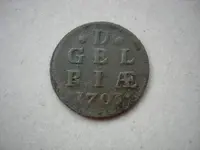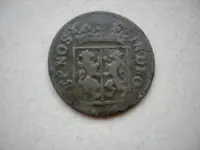Eggie said:
Here my best duit (copper in English?) from 1703. It is a 1/8 part of a 5 cent.
From the state Gelria when Holland was a republic.
This one is in very good state, normaly they are to bad to read.
Nice Duit Eggie, yes it is hard to find one anymore in Holland in a condition where you can read the date!
Much different than in 85 when I first started detecting. Then they came out of the ground in great condition,
some of them had the condition of a newly minted coin! The 'acid' rain and more and more chemicals and
fertilizers used on the fields have just ruined them. That is because of the wetness of the soil combined
with the chemicals, if the soil was mostly dry they would have lasted longer.
About the Duit, it is not a copper in English. A Duit was lowest value coin in Holland (in copper), and in the UK it
was the equivalent of a farthing.
8 Duiten were worth a 'Stuiver' 20 Duiten or 8 stuivers were worth a silver Gulden.
In the 19th century some UK colonies also had the Stiver, which was a name derived from the Dutch Stuiver.
There was also later a 4 Duit coin (also called a Plak because it was quite large) and a half 'Stuiver' which was
worth 4 Duiten.
The VOC (the United East Indian Company, the first multinational corporation in the world located in Holland)
was so powerful back in the 17th century that they manufactured their own Duit coins. The Duiten were more valuable,
4 in a Stuiver. Besides minting coins they could wage war, make treaties, and establish colonies without the Dutch
Governments approval (just like it seems the modern multinationals!).



